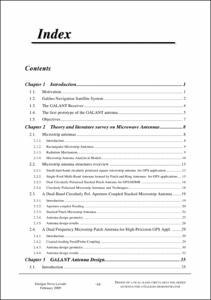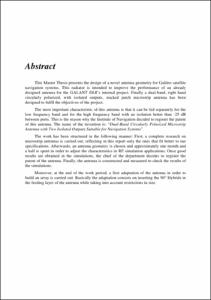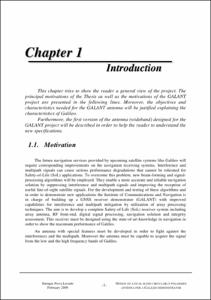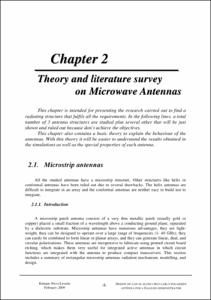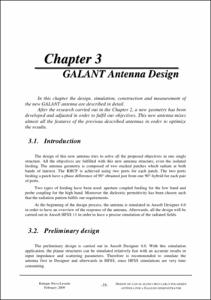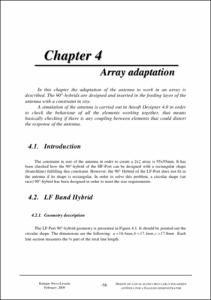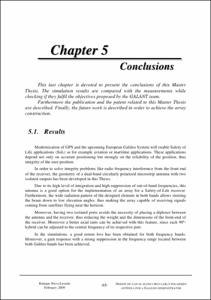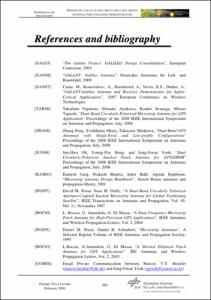Mostra el registre d'ítem simple
Design of a dual-band circularly polarized antenna for a Galileo Demonstrator
| dc.contributor | Jofre Roca, Lluís |
| dc.contributor.author | Nova Lavado, Enrique |
| dc.contributor.other | Universitat Politècnica de Catalunya. Departament de Teoria del Senyal i Comunicacions |
| dc.date.accessioned | 2009-06-05T09:16:20Z |
| dc.date.available | 2009-06-05T09:16:20Z |
| dc.date.issued | 2009-02 |
| dc.identifier.uri | http://hdl.handle.net/2099.1/6984 |
| dc.description | Projecte fet en col.laboració amb l'empresa DLR |
| dc.description.abstract | This Master Thesis presents the design of a novel antenna geometry for Galileo satellite navigation systems. This radiator is intended to improve the performance of an already designed antenna for the GALANT DLR’s internal project. Finally a dual-band, right hand circularly polarized, with isolated outputs, stacked patch microstrip antenna has been designed to fulfil the objectives of the project. The most important characteristic of this antenna is that it can be fed separately for the low frequency band and for the high frequency band with an isolation better than -25 dB between ports. This is the reason why the Institute of Navigation decided to register the patent of this antenna. The name of the invention is: “Dual-Band Circularly Polarized Microstrip Antenna with Two Isolated Outputs Suitable for Navigation Systems”. The work has been structured in the following manner: First, a complete research on microstrip antennas is carried out, reflecting in this report only the ones that fit better to our specifications. Afterwards, an antenna geometry is chosen and approximately one month and a half is spent in order to adjust the characteristics in RF simulation applications. Once good results are obtained in the simulations, the chief of the department decides to register the patent of the antenna. Finally, the antenna is constructed and measured to check the results of the simulations. Moreover, at the end of the work period, a first adaptation of the antenna in order to build an array is carried out. Basically the adaptation consists on inserting the 90° Hybrids in the feeding layer of the antenna while taking into account restrictions in size. |
| dc.language.iso | eng |
| dc.publisher | Universitat Politècnica de Catalunya |
| dc.rights | Attribution-NonCommercial-NoDerivs 3.0 Spain |
| dc.rights.uri | http://creativecommons.org/licenses/by-nc-nd/3.0/es/ |
| dc.subject | Àrees temàtiques de la UPC::Enginyeria de la telecomunicació::Radiocomunicació i exploració electromagnètica::Satèl·lits i ràdioenllaços |
| dc.subject | Àrees temàtiques de la UPC::Enginyeria de la telecomunicació::Radiocomunicació i exploració electromagnètica::Antenes i agrupacions d'antenes |
| dc.subject.lcsh | Galileo satellite navigation system |
| dc.subject.lcsh | Microstrip antennas |
| dc.subject.other | Microstrip antenna |
| dc.title | Design of a dual-band circularly polarized antenna for a Galileo Demonstrator |
| dc.type | Master thesis (pre-Bologna period) |
| dc.subject.lemac | Galileo (Sistema de posicionament) |
| dc.subject.lemac | Antenes microstrip |
| dc.rights.access | Open Access |
| dc.audience.educationlevel | Estudis de primer/segon cicle |
| dc.audience.mediator | Escola Tècnica Superior d'Enginyeria de Telecomunicació de Barcelona |
| dc.audience.degree | ENGINYERIA DE TELECOMUNICACIÓ (Pla 1992) |



